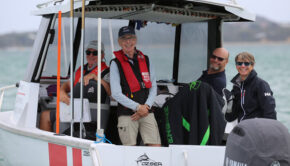COVID-19: Heightened diligence needed
Published on October 7th, 2020
The coronavirus hasn’t traveled the world on its own plane ticket, so for sailing to help minimize its movement, Scuttlebutt has encouraged the promotion of local regattas.
But more so, as sailors may choose to take personal risks to compete, the greatest consideration for any regatta host should be the event volunteers, host club members, and the local community.
Fortunately, sailing is an outdoor sport which is an environment less able to spread the virus, but even so, the latest update from medical experts recognizes how it is easier to get COVID-19 than previously stated. Here’s a report on the new details from NPR:
The Centers for Disease Control and Prevention now says the coronavirus can be spread through airborne particles that can linger in the air “for minutes or even hours” — even among people who are more than 6 feet apart.
The CDC still says that SARS-COV-2, the virus that causes COVID-19, is most frequently spread among people in close contact with one another, through respiratory droplets produced when an infected person coughs, sneezes or talks.
But in new guidance published October 5 on its website, the agency also acknowledged that under certain circumstances, people have become infected by smaller particles that can linger in the air in enclosed spaces that are poorly ventilated.
“Sometimes the infected person was breathing heavily, for example while singing or exercising,” the CDC said. In such cases, the CDC said, there’s evidence that the amount of smaller infectious droplets and particles that a contagious person produces “became concentrated enough to spread the virus to other people” – even if they were more than 6 feet away.
In some cases, the CDC said, transmission occurred “shortly after the person with COVID-19 had left” the room.
Many experts who study the airborne transmission of viruses have been warning that the coronavirus can spread through the air for months.
Last month, many experts cheered when the CDC seemed to address the issue, posting an update that suggested that aerosols – tiny airborne particles expelled from a person’s mouth when they speak, sing, sneeze or breathe — might be among the most common ways the coronavirus is spreading.
But the agency took down that guidance a few days later, saying it was a draft proposal that was posted to its website in error. The CDC’s latest guidance stops short of calling airborne transmission “common.”
So how does this affect how we should protect ourselves in practical terms? Experts continue to advise people to wear a mask whenever they are indoors with people outside of their household pod – even if they are standing more than 6 feet apart, or even in a situation where a plexiglass barrier is in place.
Also, masks are a good idea outdoors if you are going to be in prolonged contact with people not in your household, even if you are more than 6 feet apart. “It’s a grayish area where I think adopting the precautionary principle is best,” said Linsey Marr, a professor of engineering at Virginia Tech and an expert in aerosol science.
It also means that “ventilation really is just so important,” said Kimberly Prather, an atmospheric chemist at Scripps Institution of Oceanography and lead author of the Science letter. She recommends opening doors and windows, moving gatherings outdoors whenever possible, and the use of standalone air filters in rooms.
In addition to improving ventilation indoors, the CDC said people should stay at least 6 feet away from others whenever possible, avoid crowded indoors spaces and – as always – wash their hands regularly.









 We’ll keep your information safe.
We’ll keep your information safe.